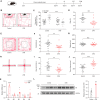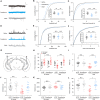Acetylcholine Muscarinic Receptors in Ventral Hippocampus Modulate Stress-Induced Anxiety-Like Behaviors in Mice
- PMID: 33384583
- PMCID: PMC7769836
- DOI: 10.3389/fnmol.2020.598811
Acetylcholine Muscarinic Receptors in Ventral Hippocampus Modulate Stress-Induced Anxiety-Like Behaviors in Mice
Abstract
Chronic stress exposure increases the risk of developing various neuropsychiatric illnesses. The ventral hippocampus (vHPC) is central to affective and cognitive processing and displays a high density of acetylcholine (ACh) muscarinic receptors (mAChRs). However, the precise role of vHPC mAChRs in anxiety remains to be fully investigated. In this study, we found that chronic restraint stress (CRS) induced social avoidance and anxiety-like behaviors in mice and increased mAChR expression in the vHPC. CRS increased the vHPC ACh release in behaving mice. Moreover, CRS altered the synaptic activities and enhanced neuronal activity of the vHPC neurons. Using pharmacological and viral approaches, we showed that infusing the antagonist of mAChRs or decreasing their expression in the vHPC attenuated the anxiety-like behavior and rescued the social avoidance behaviors in mice probably due to suppression of vHPC neuronal activity and its excitatory synaptic transmission. Our results suggest that the changes of neuronal activity and synaptic transmission in the vHPC mediated by mAChRs may play an important role in stress-induced anxiety-like behavior, providing new insights into the pathological mechanism and potential pharmacological target for anxiety disorders.
Keywords: acetylcholine muscarinic receptors; anxiety; chronic stress; electrophysiology; hippocampus; scopolamine.
Copyright © 2020 Mei, Zhou, Sun, Liu, Zhang, Liu and Shu.
Conflict of interest statement
The authors declare that the research was conducted in the absence of any commercial or financial relationships that could be construed as a potential conflict of interest.
Figures





Similar articles
-
Astrocytes in the Ventral Hippocampus Bidirectionally Regulate Innate and Stress-Induced Anxiety-Like Behaviors in Male Mice.Adv Sci (Weinh). 2024 Oct;11(38):e2400354. doi: 10.1002/advs.202400354. Epub 2024 Aug 9. Adv Sci (Weinh). 2024. PMID: 39120568 Free PMC article.
-
Anxiolytic effects of muscarinic acetylcholine receptors agonist oxotremorine in chronically stressed rats and related changes in BDNF and FGF2 levels in the hippocampus and prefrontal cortex.Psychopharmacology (Berl). 2017 Feb;234(4):559-573. doi: 10.1007/s00213-016-4498-0. Epub 2016 Dec 12. Psychopharmacology (Berl). 2017. PMID: 27957715
-
Ventral hippocampal diacylglycerol lipase-alpha deletion decreases avoidance behaviors and alters excitation-inhibition balance.Neurobiol Stress. 2022 Dec 20;22:100510. doi: 10.1016/j.ynstr.2022.100510. eCollection 2023 Jan. Neurobiol Stress. 2022. PMID: 36594052 Free PMC article.
-
Arbitration of Approach-Avoidance Conflict by Ventral Hippocampus.Front Neurosci. 2020 Dec 17;14:615337. doi: 10.3389/fnins.2020.615337. eCollection 2020. Front Neurosci. 2020. PMID: 33390895 Free PMC article. Review.
-
Muscarinic acetylcholine receptors in the hippocampus, neocortex and amygdala: a review of immunocytochemical localization in relation to learning and memory.Prog Neurobiol. 1999 Aug;58(5):409-71. doi: 10.1016/s0301-0082(98)00092-6. Prog Neurobiol. 1999. PMID: 10380240 Review.
Cited by
-
Exercise ameliorates anxious behavior and promotes neuroprotection through osteocalcin in VCD-induced menopausal mice.CNS Neurosci Ther. 2023 Dec;29(12):3980-3994. doi: 10.1111/cns.14324. Epub 2023 Jul 4. CNS Neurosci Ther. 2023. PMID: 37402694 Free PMC article.
-
mGluR5 in hippocampal CA1 pyramidal neurons mediates stress-induced anxiety-like behavior.Neuropsychopharmacology. 2023 Jul;48(8):1164-1174. doi: 10.1038/s41386-023-01548-w. Epub 2023 Feb 16. Neuropsychopharmacology. 2023. PMID: 36797374 Free PMC article.
-
The Oscillatory Profile Induced by the Anxiogenic Drug FG-7142 in the Amygdala-Hippocampal Network Is Reversed by Infralimbic Deep Brain Stimulation: Relevance for Mood Disorders.Biomedicines. 2021 Jul 6;9(7):783. doi: 10.3390/biomedicines9070783. Biomedicines. 2021. PMID: 34356846 Free PMC article.
-
Septohippocampal cholinergic system at the intersection of stress and cognition: Current trends and translational implications.Eur J Neurosci. 2024 May;59(9):2155-2180. doi: 10.1111/ejn.15999. Epub 2023 May 10. Eur J Neurosci. 2024. PMID: 37118907 Free PMC article. Review.
-
Clinical Effectiveness of Muscarinic Receptor-Targeted Interventions in Neuropsychiatric Disorders: A Systematic Review.CNS Drugs. 2022 Nov;36(11):1171-1206. doi: 10.1007/s40263-022-00964-8. Epub 2022 Oct 21. CNS Drugs. 2022. PMID: 36269510 Free PMC article.
References
-
- Bannerman D. M., Yee B. K., Good M. A., Heupel M. J., Iversen S. D., Rawlins J. N. P. (1999). Double dissociation of function within the hippocampus: a comparison of dorsal, ventral, and complete hippocampal cytotoxic lesions. Behav. Neurosci. 113, 1170–1188. 10.1037/0735-7044.113.6.1170 - DOI - PubMed
LinkOut - more resources
Full Text Sources

